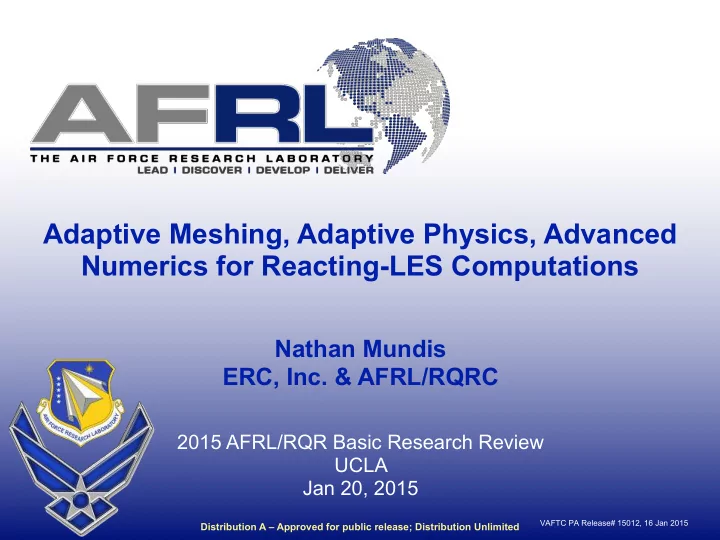

Adaptive Meshing, Adaptive Physics, Advanced Numerics for Reacting-LES Computations Nathan Mundis ERC, Inc. & AFRL/RQRC 2015 AFRL/RQR Basic Research Review UCLA Jan 20, 2015 VAFTC PA Release# 15012, 16 Jan 2015 Distribution A – Approved for public release; Distribution Unlimited
Combustion Dynamics Distribution A – Approved for public release; Distribution Unlimited 2
Reacting-LES Unstructured Mesh Cartesian Mesh • Automatic generation • Rarely automated • Very inefficient • Highly efficient • High-order accuracy • Usually limited to 2nd order – Usually 5th or 7th order • Difficult to adapt • Amenable to adaption • Good at capturing geom • Poor geometry defn • Very good for boundary • Poor for boundary layer layers Distribution A – Approved for public release; Distribution Unlimited 3
Dual-Mesh Paradigm Combine unstructured near-body with Cartesian off-body CREATE-AV Infrastructure Use domain connectivity to exchange data between two mesh systems Distribution A – Approved for public release; Distribution Unlimited 4
Goals Develop dual-mesh algorithms for reacting-LES 1. Extend existing automated strand-Cartesian gridding techniques for internal flows 2. Develop off-body Cartesian adaptive meshing strategies for turbulent reacting flows 3. Devise adaptive physics approach for combustion 4. Employ optimal numerics for reacting-LES Project is part of the AFOSR/Test and Evaluation Portfolio � - Dr. Michael Kendra as Program Officer � - Dr Terrance Dubreus - AEDC - as tech transition advisor Distribution A – Approved for public release; Distribution Unlimited 5
Strand Grids and Internal Flows Protypical Internal Geometries Strand Grids Automated volume grid High-order accuracy Enhanced scalability Distribution A – Approved for public release; Distribution Unlimited 6
Adaptive Meshing Adaptive Algorithms • Current methods – New grid level based on vorticity detection – Refinement terminated based on Richardson extrapolation • Reacting-LES – Is vorticity suficient? – Use other detection & termination methods? – Heat release, temperature gradients, etc. Distribution A – Approved for public release; Distribution Unlimited 7
Adaptive Physics • Combustion calculations are extremely expensive – Detailed combustion kinetics • Large number of species and reaction steps – Turbulent combustion closures • Linear Eddy Model involves sub-grid solutions • Silver Lining – Detailed chemistry & closures needed only locally – Most of the flowfield has unburnt or burned propellants • Devise adaptive physics approach – Apply detailed models only in local blocks – Block-based solver structure is ideally suited to adaptive physics implementation Distribution A – Approved for public release; Distribution Unlimited 8
Modular Physics Different grid Domain connectivity blocks can use provides data transfer different physics between blocks Distribution A – Approved for public release; Distribution Unlimited 9
Advanced Numerics Distribution A – Approved for public release; Distribution Unlimited 10
Distribution A – Approved for public release; Distribution Unlimited 11
Distribution A – Approved for public release; Distribution Unlimited 12
Distribution A – Approved for public release; Distribution Unlimited 13
Distribution A – Approved for public release; Distribution Unlimited 14
Distribution A – Approved for public release; Distribution Unlimited 15
Distribution A – Approved for public release; Distribution Unlimited 16
Distribution A – Approved for public release; Distribution Unlimited 17
Distribution A – Approved for public release; Distribution Unlimited 18
Distribution A – Approved for public release; Distribution Unlimited 19
High-Order Time Schemes Phase error for high- order spatial schemes without accounting for temporal discretization Phase error for high-order temporal schemes Distribution A – Approved for public release; Distribution Unlimited 20
Summary • New LRIR project awarded in FY15 – Research in technologies for the next-gen CFD solver for reacting LES for rocket propulsion • Focus areas – Dual mesh paradigm for internal flows – Cartesian adaptive meshing for reacting-LES – Adaptive physics for kinetics and turbulent combustion – Optimal numerics for minimal dissipation/discretization Distribution A – Approved for public release; Distribution Unlimited 21
Recommend
More recommend